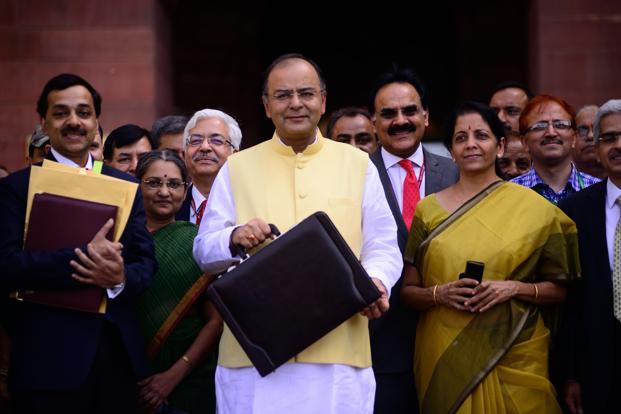Budget Stories of 2014-15
Jaitley moves gently with maiden budget
After presenting his maiden budget, Finance Minister Arun Jaitley’s body language and utterances were reminiscent of a student complaining about lack of time for preparing for examinations which resulted in low scores. Even Jaitley said (during his budget speech as well as during post-budget interactions) that in 45 days nothing much could have been done. But one should remember that, in 1991, then Finance Minister Manmohan Singh had even less time than Jaitley and still he was able to present a dream budget. Further, Jaitley was the opposition leader in the Rajya Sabha for the last 10 years during which he must have criticised as many budgets.
If his maiden budget is any indication, Arun Jaitley will go into history books as the most undistinguished Finance Minister India ever had during the last two decades. The phase of indecisiveness which was the hallmark of UPA II still persists and the NDA government doesn’t seem to have any problem in carrying forward this legacy.
Take the case of the retrospective amendment which the then Finance Minister, Pranab Mukherjee, introduced in 2012. Jaitley preferred to maintain status quo by saying that a committee would be appointed to look into the matter. But the fact is that the high-level Shome Committee has already suggested scrapping of the draconian amendment. Maybe, the FM wants to buy some time before taking any decision on the matter which may also rub the President the wrong way. By then if the International Arbitration set up for the purpose comes out with its award, Jaitley can simply take shelter under its judgment and make necessary changes in the Act.
But the damage caused by the confusion prevailing over the issue in terms of held-back investments by the foreigners is immense and prompt action would have been lauded. Even countries like Brazil and the whole of East European Block don’t have a right (in their constitution) to bring retrospective amendments in their law. Why should India make an exception?
The FM, who gave one of the longest budget speeches, could not find the time to talk about with great clarity how the General Anti Avoidance Rule (GAAR) would be implemented. The GAAR is to come into effect from FY15-16 and it is already legislated. If the intention of the government is not to implement, then a legislative amendment is required but the Finance Minister has remained silent on the subject. Lack of clarity on the issue has resulted in heavy selling in stock markets post-budget and continued volatility in the stock markets could throw the government’s divestment target off track.
The FM has touched upon the country’s infrastructure needs in greater detail which is laudable. In one such proposal he said that the regulatory requirement with respect to CRR and SLR would not be applicable in case of banks issuing long-term infrastructure bonds. This essentially means that banks now have a big incentive to expand lending to existing infrastructure companies. But the reality is that almost all infrastructure companies are already overleveraged and struggling to find ways and means to reduce their debt burden. Many of them, like Nagarjuna, HCC and GMR, are readying to approach the capital market to reduce their debt burden by raising money by diluting equity. In such a scenario, whether the FM’s new announcement will help the infrastructure companies is anybody’s guess.
The budget has many positives for the realty sector too and some tax concessions for homebuyers. Whether these giveaways will result in increased demand for the sector is too early to say. One of the reasons for slackness in demand is the high cost of houses and also the high prevailing interest rates for home loans. Unless these problems are tackled it may be difficult to attract homebuyers in large numbers in the near future.
And lastly, some of the budget provisions are expansionary in their impact and may result in inflation reversing its downward trend. The FM should have been careful while dealing with this problem, especially as the country is staring at one of the worst drought seasons.
To conclude, after watching Arun Jaitley deliver his budget speech for more than two hours, it is clear that the health of the Finance Minister is no better than that of the Indian economy. One only hopes that by the time the next budget is announced (which is barely eight months away) we have enough good things to write about both.
Budget offers ray of hope to road sector
Highway developers are upbeat after Union Finance Minister Arun Jaitley presented his maiden budget in the Parliament on July 10th. The optimism and renewed vigor expressed by the road sector following presentation of the Union Budget 2014 – 15 need not come as a surprise.
As the National Highways Builders Federation, the representative body of highway developers, said in its reaction to the Budget, the policy paralysis that plagued the previous government had put the sector on hold. The present government, on the other hand, is sending the right signals through the Budget.
The Finance Minister in his budget speech recognized the road sector as an important artery of communication in the country and stressed on the need to feed its huge investment requirements as well as carry out debottlenecking from the maze of clearances. An amount of Rs. 37,880 crore, which includes Rs. 3,000 crore for the North East, has been proposed for investment in the National Highways Authority of India and state roads. The target for national highways construction in the current financial year has been set at 8,500 km. The Budget also emphasized that the country needs an efficient transport network to ensure faster travel and improve the supply chain in transporting goods across cities. The government would initiate work on select expressways in parallel to the development of industrial corridors. The NHAI would set aside a sum of Rs. 500 crore for project preparation. For improving access in rural India, a sum of Rs. 14,389 crore has been allocated for the Pradhan Mantri Gram Sadak Yojana.
Highway developers expect that in addition to the allocation for the road sector, some of the other measures announced in the Budget will go a long way in accelerating the pace of road construction in the country. The measures include providing a conducive tax regime for Infrastructure Investment Trusts to be set up in accordance with the regulations of the Securities and Exchange Board of India, encouraging banks to extend long term loans to the infrastructure sector with flexible structuring to absorb potential adverse contingencies, sometimes known
as the 5/25 structure, permitting banks to raise long term funds for lending to the infrastructure sector with minimum regulatory preemption such as Cash Reserve Ratio, Statutory Liquidity Ratio and Priority Sector Lending, focusing on harnessing of private capital and expertise through the Public Private Partnership model for development of infrastructure in various sectors and setting up an institution called 3P India with a corpus of Rs. 500 crore to provide support to mainstreaming PPPs.
The NHBF said the measure to exempt banks from maintaining CRR, SLR and PSL on funds raised to finance infrastructure loans could prove to be a game changer in infrastructure financing. The Finance Minister had mentioned in his budget speech that long term financing for infrastructure posed a major challenge to greater private sector participation in the sector.
No major impact of anti-dumping duty on cost of solar power, claim Indian solar manufacturers
Imposing anti-dumping duty on solar modules, panels and glass exported from USA, Malaysia, China and Taiwan, as recommended by the Directorate General of Anti-Dumping and Allied Duties – Ministry of Commerce, will not lead to a significant increase in the cost of solar power and instead facilitate flow of investment, both domestic as well as foreign, into the solar power sector thereby boosting the country’s economy, claim Indian solar manufacturers.
The final decision with regard to imposing the anti-dumping duty, ranging from 11 cents per watt peak to a maximum of 81 cents per watt peak, on dumped imports of solar cells and modules will be taken by the Ministry of Finance.
Minister of State (Independent Charge) for Coal, Power and New and Renewable Energy Piyush Goyal has already sought review of the recommendation made by the Directorate General of Anti-Dumping and Allied Duties on the ground that the country lacks adequate solar manufacturing capacity.
Many among those opposed to the recommendation of the Directorate General of Anti-Dumping and Allied Duties argue that the prices of Indian solar cells and modules are very high. They claim imposing the anti-dumping duty will jeopardize 4,000 MW of solar power projects and also double the cost of solar power.
Countering the claims made by those opposed to the anti-dumping duty, the Indian Solar Manufacturers’ Association, which represents 25 domestic solar manufacturers, said in a recent press statement that the current price of unsubsidized solar power was in the range of Rs. 7.5 – Rs. 8.5 per kWh and imposing the anti-dumping duty would lead to an increase of only 6 – 8 percent in price. The overall price of power at the billing point of the consumer would be a mere 2 to 3 paisa per kWh more based on the present energy mix, it added.
The representative body of domestic solar manufacturers pointed out that once the government laid down a clear manufacturing policy for solar equipment, the success experienced in the automobile sector could be replicated in the solar power sector.
“There is strong international and domestic investor interest in solar manufacturing in India. Investors are awaiting clear message from government to ramp up their manufacturing program in India. With its abundant solar resources, India will lead the world in solar energy,” it said.
ISMA said that setting up the total solar manufacturing chain in the country would result in zero imports and fall in prices. It added that Indian solar manufacturers including Tata Power had announced capacity expansion of 300 MW in response to the recommendation made by the Directorate General of Anti-Dumping and Allied Duties.
Stressing on the need to encourage domestic solar manufacturers, ISMA said the country’s economy would receive a major boost if the existing solar power programme totaling 20,000 MW and worth Rs. 1,50,000 crore actually translated to manufacturing. It said a renewable energy policy based on self sufficiency, conservation of foreign exchange and promotion of domestic manufacturing would halt the massive outflow of foreign exchange and attract foreign direct investments to solar manufacturing.
ISMA also rejected the claim that the anti-dumping duty would jeopardize solar power projects of 4,000 MW capacity. It said solar power projects of only 975 MW capacity were pending at present. The other projects, it added, could not take off due to reasons unrelated to the anti-dumping duty.
On the pricing issue, ISMA said that Indian modules were competitive in price as well as quality in markets such as the European Union and Japan, which provided a level playing field.
“When the price of something is low because a foreign government is subsidizing it, then it is an artificial price. This is bound to correct over time,” it said.
The USA and European Union have already imposed anti-dumping duties on solar cells and modules from China.
India increases FDI in defence sector to 49%
Foreign defence and military hardware companies will be elated over Finance Minister Arun Jaitley’s announcement of increase in FDI in defence manufacturing from the existing 26 per cent to 49 per cent with full Indian management and control. This will be through the FIPB route.
The allocation for the defence sector in the general budget has been raised by Rs. 5,000 crore to Rs. 2,29,000 crore. This includes a sum of Rs. 1,000 crore for accelerating the development of a strategic railway system in the border areas.
The capital outlay will be used to modernise all three wings of the Indian armed forces. The government also plans to streamline the defence procurement process to make it speedy and more efficient.
“India today is the largest buyer of defence equipment in the world. Our domestic manufacturing capacities are still at a nascent stage. We are buying a substantial part of our defence requirements directly from foreign players. Companies controlled by foreign governments and foreign private sector are supplying our defence requirements to us at a considerable outflow of foreign exchange. Currently, we permit 26 per cent FDI in defence manufacturing. The composite cap of foreign exchange is being raised to 49 per cent with full Indian management and control through the FIPB route,” Jaitley said in his budget speech.
In 2011, the erstwhile UPA government announced a separate fund to provide necessary resources to public and private sector companies, including SMEs and academic and scientific institutions, to support research and development of defence systems that enhanced cutting-edge technology capability. But, apparently, no action was taken beyond the announcement. The NDA government has now set aside an initial sum of Rs. 100 crore to set up a Technology Development Fund to support this objective.
The finance minister also announced setting up a war memorial, a war museum and a national police memorial.












